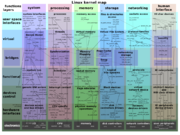
Linux architecture
Encyclopedia

Unix-like
A Unix-like operating system is one that behaves in a manner similar to a Unix system, while not necessarily conforming to or being certified to any version of the Single UNIX Specification....
computer operating system. It has been ported to a vast variety of computer architectures.
File system
Its file systemFile system
A file system is a means to organize data expected to be retained after a program terminates by providing procedures to store, retrieve and update data, as well as manage the available space on the device which contain it. A file system organizes data in an efficient manner and is tuned to the...
like all Unix
Unix
Unix is a multitasking, multi-user computer operating system originally developed in 1969 by a group of AT&T employees at Bell Labs, including Ken Thompson, Dennis Ritchie, Brian Kernighan, Douglas McIlroy, and Joe Ossanna...
systems is based on one root directory, or hierarchical top point with subdirectories underneath it. Some sub-directories act as mount points, where different physical or networked file systems may be incorporated.
The hardware is also incorporated into the file hierarchy. Device drivers interface to user applications via an entry in the /dev directory. Process information as well is mapped to the file system through the /proc directory.
Unix security systems were designed into the architecture. Raw hardware devices are protected from direct access, and the file system has an inbuilt security system giving individual access to files on three levels, user only, group membership, and world access. Each category has read, executable and write flags that may be set in any combination.
Kernel -or- System Software
The Linux kernelLinux kernel
The Linux kernel is an operating system kernel used by the Linux family of Unix-like operating systems. It is one of the most prominent examples of free and open source software....
includes true multitasking, virtual memory
Virtual memory
In computing, virtual memory is a memory management technique developed for multitasking kernels. This technique virtualizes a computer architecture's various forms of computer data storage , allowing a program to be designed as though there is only one kind of memory, "virtual" memory, which...
, shared libraries, demand loading, shared copy-on-write
Copy-on-write
Copy-on-write is an optimization strategy used in computer programming. The fundamental idea is that if multiple callers ask for resources which are initially indistinguishable, they can all be given pointers to the same resource...
executables, proper memory management
Memory management
Memory management is the act of managing computer memory. The essential requirement of memory management is to provide ways to dynamically allocate portions of memory to programs at their request, and freeing it for reuse when no longer needed. This is critical to the computer system.Several...
, and TCP/IP networking
Computer network
A computer network, often simply referred to as a network, is a collection of hardware components and computers interconnected by communication channels that allow sharing of resources and information....
.
Today Linux is a module-loading monolithic kernel
Monolithic kernel
A monolithic kernel is an operating system architecture where the entire operating system is working in the kernel space and alone as supervisor mode...
. Device driver
Device driver
In computing, a device driver or software driver is a computer program allowing higher-level computer programs to interact with a hardware device....
s and kernel extensions typically run in ring 0, with full access to the hardware, although some run in user space
User space
A conventional computer operating system usually segregates virtual memory into kernel space and user space. Kernel space is strictly reserved for running the kernel, kernel extensions, and most device drivers...
. Unlike standard monolithic kernels, device drivers are easily configured as modules, and loaded or unloaded while running the system. Also unlike standard monolithic kernels, device drivers can be pre-empted under certain conditions. This latter feature was added to handle hardware interrupts correctly, and to improve support for symmetric multiprocessing
Symmetric multiprocessing
In computing, symmetric multiprocessing involves a multiprocessor computer hardware architecture where two or more identical processors are connected to a single shared main memory and are controlled by a single OS instance. Most common multiprocessor systems today use an SMP architecture...
. Preemption also improves latency, increasing responsiveness and making Linux more suitable for real-time applications.
The complete source code of various versions of the Linux kernel can be browsed at http://lxr.linux.no .
The complete source code of the latest versions of the Linux kernel can be downloaded from http://www.kernel.org .

